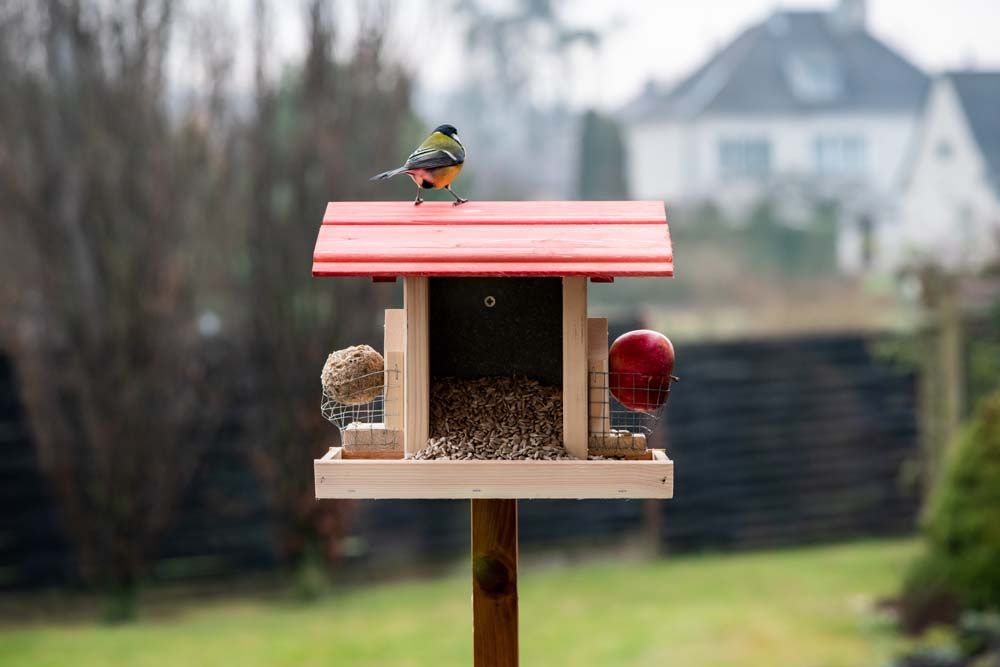Beating Bird Feeder Bully Birds


We all know that mammals and bird feeders don’t mix. Squirrels wreak havoc, of course, but mice, raccoons, rats, chipmunks, possums, and even bears can cause trouble too. They make messes, consume the seed and suet you intended for the birds, and, perhaps worst of all, scare away the birds you were trying to attract in the first place.
But there’s another threat that can scare birds away from your feeders—surprisingly, it’s other birds!
It’s not that bird watchers are uninterested in blue jays, crows, grackles, pigeons, starlings, blackbirds, or cowbirds—but there are downsides to attracting these “bully” birds to feeders. They tend to monopolize the feeders, chasing timid birds away and refusing to let others share the fun.
These bully birds can eat quickly, sometimes cleaning out your feeders in a day and thus making more work for you. They can instigate squabbles among species. So if you’re looking for ways to discourage bully birds and give the small finches, nuthatches, and chickadees a chance for a bite to eat, here are a few things you can try:
1. Use a Caged Bird Feeder
At first glance these may seem like overkill, but they really do work. A regular bird feeder surrounded by a cage with grills of a precise size will allow your delightful and timid songbirds to glide in and eat, but prevent larger bully birds from getting through. Once the larger birds see that entry is impossible, they may move on to other food sources.
2. Try a Feeder with a Tiny Perch
Naturally, larger birds with larger feet require larger places to land—so if your goal is to encourage more chickadees, nuthatches, orioles, goldfinches, or other petite birds, consider choosing a feeder that is designed specifically for small visitors. This could mean swapping out platform-style bird feeders and putting up ones with perches. Keeping the perch small not only discourages birds with larger feet from hanging on, it makes it more difficult for them land at all.
3. Create a Curated Menu
It can be useful to think about the preferred diets of the birds you want to attract as well as the diets of the birds you’re trying to discourage. Small seeds with shells—safflower and thistle seeds are often recommended—as well as millet or cracked corn make fine dining for chickadees, cardinals, finches, and the like. But bully birds typically don’t prefer these seeds and will probably take their business elsewhere (though they may leave your feeder a poor Yelp review!).
4. Install a Roof
Hanging a baffle—it looks basically like a lampshade—over the top of your bird feeder has two benefits. It definitely helps keep squirrels from accessing the feeder, but it also discourages some of the bully birds who may be averse to flying under the cover. But little birds rarely mind, and will happily fly down, under, and up to chow down inside the shade of the baffle.
5. Keep Feed off the Ground
Ground feeders are handy and easy to use, but they’re an easy invitation for bully birds, so if you’re having a problem you might need to eliminate this style of feeder. Likewise, spilled seeds on the ground attract bully birds (not to mention squirrels and all the rest), so you might experiment with placing an open trash can or similar object beneath your hanging feeder to catch lost seeds.
Of course, this leads to the issue of the trash can filling with water, blowing away, its poor aesthetic, etc. Decisions like these can make a birder question just how important it is to battle the bully birds. And that leads us to our last suggestion:
6. Try to Keep them all Happy
If all else fails—or you want to try to be an unbiased birder—you can always try to install multiple bird feeders around your property. Some could be designed in the ways mentioned in order to encourage songbirds and similar petite avians, while others can be large platform feeders full of things bully birds love. It won’t always work, but maybe you can create a win/win situation for everyone (including you).
Tags:Country Critters

Acreage Life is part of the Catalyst Communications Network publication family.
















